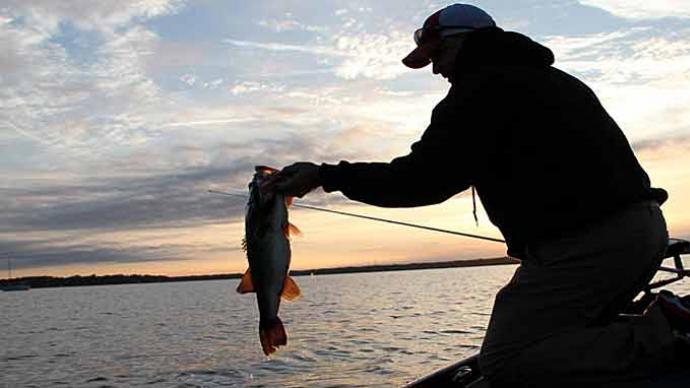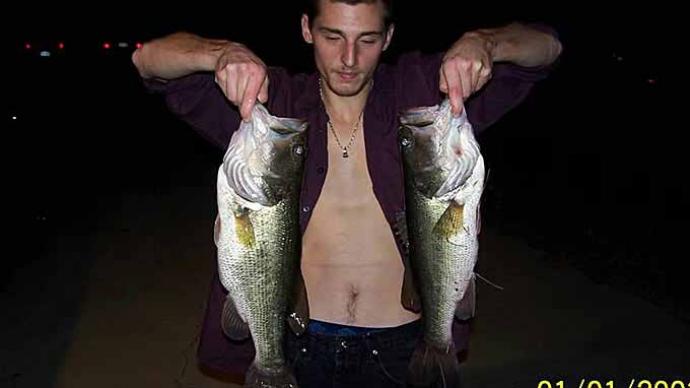
Summertime offers bass anglers the best opportunity to land a lunker during the darkness of night. Telemetry studies have shown that largemouth bass concentrate as much as 90 percent of their activity during nighttime hours, when the water temperature is above 70 degrees.
In most of the southern United States, this period usually begins in May and extends through the end of August. As September begins, bass quicky revert back to a daytime feeding pattern.
Several factors determine if a lake is a good nighttime lunker lake. One of the most important factors is water clarity. Stained water, or areas of the lake that are not clear, generally offer poor nighttime fishing. Lakes with heavy boat traffic are often excellent nighttime fishing lakes. Heavy daytime traffic will often drive the bass to deeper water. When the traffic subsides, the bass will move to shallow feeding stations to feed.
Aquatic vegetation and shoreline vegetation generally create an environment more conducive to night fishing. Main-lake points are especially good when they have some type of cover such as grass or brush. When close to deep water, these areas often become feeding stations for lunker bass.
Largemouth bass usually will not reach lunker size (10 pounds or above) until they are a minimum of seven years old. When a bass is that old and that big, she will use cover as an ambush point. She will hide in the shadows of the cover and make short dashes for baitfish that are unfortunate enough to swim within a short striking distance. Seldom will a lunker bass expend the energy necessary to chase prey very far.
Since the lunker bass does not like to travel great distances to feed, it is important to find summertime feeding stations (main-lake points with adequate breaklines and cover, docks, brush, hydrilla beds, etc) that are located close to deep water. The definition of deep water can vary depending on the overall depth of the lake.
When fishing a grassy main-lake point, it is important to realize that during the day, the grass converts carbon dioxide to oxygen. Just after dark the water around aquatic vegetation such as hydrilla has some of the highest oxygen concentrations of the 24-hour period and bass will feed inside the vegetation.
During the nighttime hours, plants start using the oxygen in the water and the oxygen level will drop as darkness lingers. In the period from a few hours after dark until dawn, most of the feeding activity will move to the edge of the vegetation.
Weather can also play a vital role in the nighttime feeding activity of the largemouth bass. Although there are exception to every rule, the most productive nights are often after a still, hot, sunny day. Conversely, some of the poorest fishing nights will occur after cool, cloudy, windy days. A nighttime thunderstorm can even shut down the bite until the morning hours.
Artificial lighting, such as lights on boat houses and docks or other manmade structures, will usually draw more bass to the area during periods that have less moonlight. Also, on cloudy nights during a bright moon period, artificial lights can also attract bass.
When fishing for nighttime lunkers, it is important to find docks or boathouses that are located adjacent to deep water. Remember, a lunker bass does not like to travel great distances. Also, the most productive docks and boathouses are often the ones that have the lights on a timer that turn on at the same time every night.
When fishing a man-made structure that is illuminated with artificial light, it is generally best to position the boat in a darkened area and cast into the lighted area. It is possible to chase the fish to deeper water by getting too close to the lighted area. Also, in clearer water, the bass can actually look up and see the angler silhouetted by the artificial light.
Many anglers prefer to plan their nighttime trips when the moon is at it brightest point - usually, four days prior to the full moon through four days after the full moon. Others prefer to fish on the darkest nights.
During a full moon period, the best feeding periods will generally occur just prior to the moon rising, at its highest point overhead and as it goes down. It usually takes the moon about 13 hours to cycle from horizon to horizon.
Anglers who prefer to fish in the darkest time of the month usually prefer to fish a period beginning 10 days after the full moon and lasting for eight days.
Although largemouth bass have the ability to see in the dark, their visibility is limited by the darkened conditions. They lose the ability to distinguish different colors during low-light conditions and usually see a silhouette of the lure in the water. Dark colors such as black and blue are common colors to use during nighttime trips since they are the easiest for bass to see in limited light conditions.
It is also possible to use a braided line or heavier monofilament line during nighttime trips. Due to the reduced visibility caused by low-light conditions, the bass is less likely to see the line.
One of the most common nighttime lures is a black spinnerbait with a large Colorado blade. During dark night conditions the blade should be solid black and on moonlit nights a silver blade is preferred. The addition of a dark trailer such as a split-tail grub or a craw can enhance the effectiveness of your spinner at night.
Other popular nighttime lures are black Jitter-Bugs, black and blue jigs and 10-inch blue Power Worms. Based on historical experience, the lures that offer the best chance at a lunker bass are-black and blue jigs and 10-inch blue Power Worms.
Nighttime fishing techniques differ very little from daytime techniques. At night, most bass will be caught in water less than 15 feet deep. Although it is possible to catch bass in deeper water, the strikes come much less frequently.
Most primary and secondary points that are located adjacent to deep water will hold bass. Lunker bass tend to be very cover oriented and will usually stay close to the breakline or cover that is located the closest to deep water.
Unless the feeding station is a hydrilla bed or other types of shallow cover, it is best to sit in shallow water and cast to deeper water. Under these conditions, the bass will strike the lure and move towards the deeper water. This usually makes the strike much easier to detect.
Remember that a good nighttime trip begins with adequate planning and preparation. Good luck.




